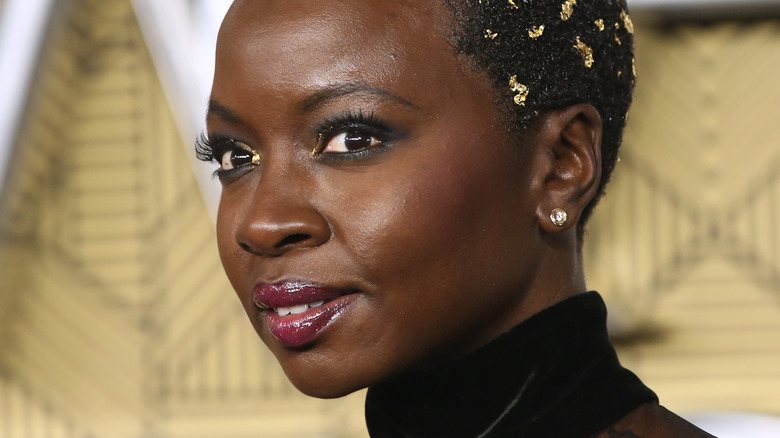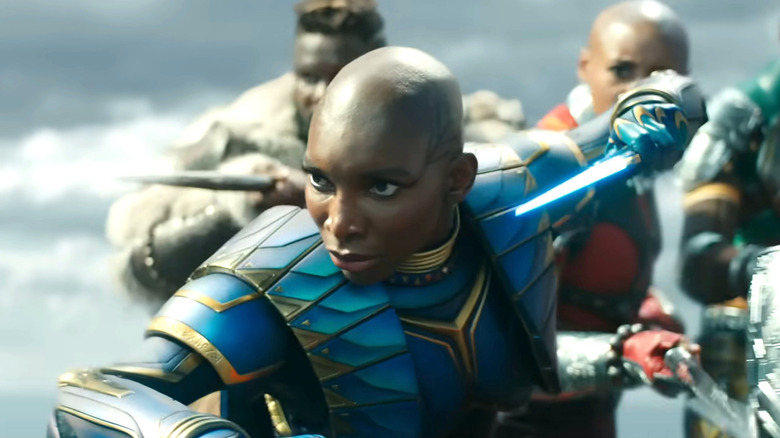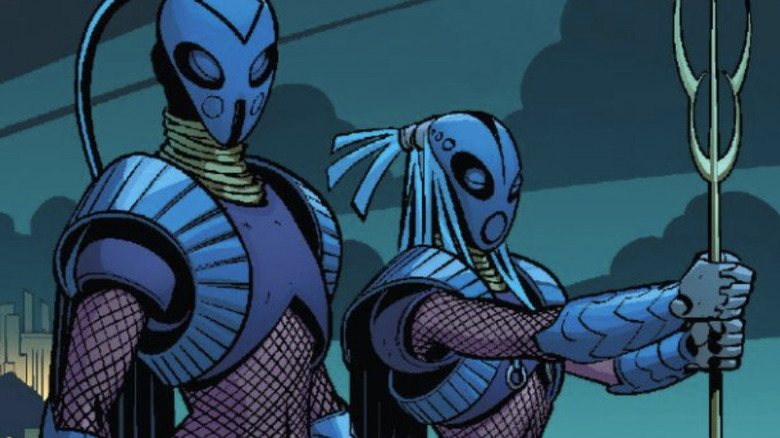What Wakanda Forever's Midnight Angels Armor Should Really Look Like
"Black Panther: Wakanda Forever" not only pays tribute to Chadwick Boseman, but it also sets several of its characters on exciting new paths within the Marvel Cinematic Universe. Shuri (Letitia Wright) undergoes the biggest and most obvious transformation of all of the characters in "Wakanda Forever." After spending much of the film struggling to move on from the loss of her brother, Shuri goes on to become the new protector of her African nation and brings an end to the dangerous conflict between Wakanda and the underwater kingdom of Talokan. The importance of Shuri's arc does not, however, mean that she's the only character who grows and transforms throughout "Wakanda Forever."
Okoye (Danai Gurira) also changes in her own ways over the course of the superhero film's 161-minute runtime. Indeed, while Okoye is still the leader of the Dora Milaje when "Wakanda Forever" begins, the "Black Panther" sequel sees Gurira's fierce warrior get surprisingly stripped of her leadership status by none other than Queen Ramonda (Angela Bassett). Fortunately, Okoye manages to climb back up quite a bit from that setback by the end of "Black Panther: Wakanda Forever."
As a matter of fact, by the time the "Black Panther" sequel cuts to black for the last time, Okoye has already donned a new suit of armor and taken on an entirely new title.
Wakanda Forever brings the Midnight Angels into the MCU
Ahead of Wakanda's final showdown with the Talokanans and their fearsome leader, Namor (Tenoch Huerta Mejía), Shuri talks Okoye into wearing a new, advanced suit of armor that she has designed. Despite her initial reservations about the idea, Okoye dons the armor, which Shuri names "Midnight Angel," during the third act of "Black Panther: Wakanda Forever."
In typical Shuri fashion, her Midnight Angel armor proves to be a powerful, game-changing piece of technology. It also, notably, prompts Okoye to form a new Wakandan fighting outfit known as the Midnight Angels alongside a fellow former member of the Dora Milaje, Aneka (Michaela Coel). While wearing her Midnight Angel armor, Okoye goes on to break her ally, Everett Ross (Martin Freeman), free from CIA captivity.
How Marvel plans to ultimately use the Midnight Angels in the MCU remains to be seen. Shuri's Midnight Angel armor isn't, of course, the only new superhero suit that's introduced in "Black Panther: Wakanda Forever," either. It does, however, bear a striking resemblance to the way the Midnight Angels' actual costumes look in the comics.
How Wakanda Forever alters the Midnight Angels
Much like it is in "Black Panther: Wakanda Forever," the design of the Midnight Angel armor in the comics consists largely of blue and gold colors. The comic book version of the armor also boasts similar shoulder pieces as the suits worn by Dana Gurira's Okoye and Michaela Coel's Aneka in "Wakanda Forever." That said, the comics' version of the Midnight Angel costume is not one full-body piece of armor the way that it is in Marvel's "Black Panther" sequel.
Instead, the comic book version of the Midnight Angel armor is separated into multiple different pieces, which means that those who wear it usually have their stomachs and arms covered solely by a protective layer of mesh material. In the comics, the Midnight Angel suits also rely on sets of retractable wings in order to fly. The Midnight Angel armor in "Wakanda Forever" is, conversely, able to make its wearers fly even without wings. Outside of a few sections of gold paint, though, the Midnight Angel helmets in both the comics and "Black Panther: Wakanda Forever" are largely similar.
All of this is to say that, despite how it alters the Midnight Angels' comic book origin story, "Black Panther: Wakanda Forever" still manages to bring a fairly faithful version of the fighting force's iconic armor to life in the MCU.


